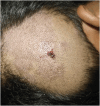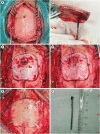Transcranial-Penetrating Craniocerebral Injury Inflicted by a Nail Gun: A Technical Case Report
- PMID: 39372112
- PMCID: PMC11450339
- DOI: 10.13004/kjnt.2024.20.e24
Transcranial-Penetrating Craniocerebral Injury Inflicted by a Nail Gun: A Technical Case Report
Abstract
This study presents a case of penetrating craniocerebral injury resulting from a nail gun accident, which is a rare etiology for penetrating brain injuries. Immediate surgical intervention is crucial to mitigate the risk of infection. The patient was a 28-year-old male who underwent craniotomy for foreign body extraction and debridement following presentation. Preoperative imaging aided in the precise localization of the injury, and guided the surgical approach. The surgical technique focused on minimizing brain tissue manipulation to prevent further damage. Postoperative care included prophylactic antibiotics and antiseizure medications. No neurological deficits or signs of infection were found on follow-up examination. Nail gun-related injuries are rare; in this case, prompt surgical intervention and meticulous postoperative care contributed to favorable outcomes, emphasizing the importance of timely management in such cases.
Keywords: Injuries; Neurosurgical procedures; Penetrating brain injuries; Wounds.
Copyright © 2024 Korean Neurotraumatology Society.
Conflict of interest statement
Conflict of Interest: The authors have no financial conflicts of interest
Figures




Comment in
-
Letter to the Editor: Commentary on Transcranial-Penetrating Craniocerebral Injury Inflicted by a Nail Gun: A Technical Case Report (Korean J Neurotrauma 2024;20:191-197).Korean J Neurotrauma. 2025 Jul 16;21(3):222-223. doi: 10.13004/kjnt.2025.21.e19. eCollection 2025 Jul. Korean J Neurotrauma. 2025. PMID: 40778258 Free PMC article. No abstract available.
Similar articles
-
Antibiotics and antiseptics for surgical wounds healing by secondary intention.Cochrane Database Syst Rev. 2016 Mar 29;3(3):CD011712. doi: 10.1002/14651858.CD011712.pub2. Cochrane Database Syst Rev. 2016. PMID: 27021482 Free PMC article.
-
Perioperative interventions in pelvic organ prolapse surgery.Cochrane Database Syst Rev. 2018 Aug 19;8(8):CD013105. doi: 10.1002/14651858.CD013105. Cochrane Database Syst Rev. 2018. Update in: Cochrane Database Syst Rev. 2025 Jul 22;7:CD013105. doi: 10.1002/14651858.CD013105.pub2. PMID: 30121957 Free PMC article. Updated.
-
Interventions for treating fingertip entrapment injuries in children.Cochrane Database Syst Rev. 2014 Apr 30;2014(4):CD009808. doi: 10.1002/14651858.CD009808.pub2. Cochrane Database Syst Rev. 2014. PMID: 24788568 Free PMC article.
-
Management outcome of a patient with a self-inflicted multiple intracranial nail impalement in a tertiary hospital in Uyo: illustrative case.J Neurosurg Case Lessons. 2025 Jun 16;9(24):CASE25103. doi: 10.3171/CASE25103. Print 2025 Jun 16. J Neurosurg Case Lessons. 2025. PMID: 40523352 Free PMC article.
-
What Are the Recurrence Rates, Complications, and Functional Outcomes After Multiportal Arthroscopic Synovectomy for Patients With Knee Diffuse-type Tenosynovial Giant-cell Tumors?Clin Orthop Relat Res. 2024 Jul 1;482(7):1218-1229. doi: 10.1097/CORR.0000000000002934. Epub 2023 Dec 28. Clin Orthop Relat Res. 2024. PMID: 38153106 Free PMC article.
Cited by
-
Letter to the Editor: Commentary on Transcranial-Penetrating Craniocerebral Injury Inflicted by a Nail Gun: A Technical Case Report (Korean J Neurotrauma 2024;20:191-197).Korean J Neurotrauma. 2025 Jul 16;21(3):222-223. doi: 10.13004/kjnt.2025.21.e19. eCollection 2025 Jul. Korean J Neurotrauma. 2025. PMID: 40778258 Free PMC article. No abstract available.
References
Publication types
LinkOut - more resources
Full Text Sources

